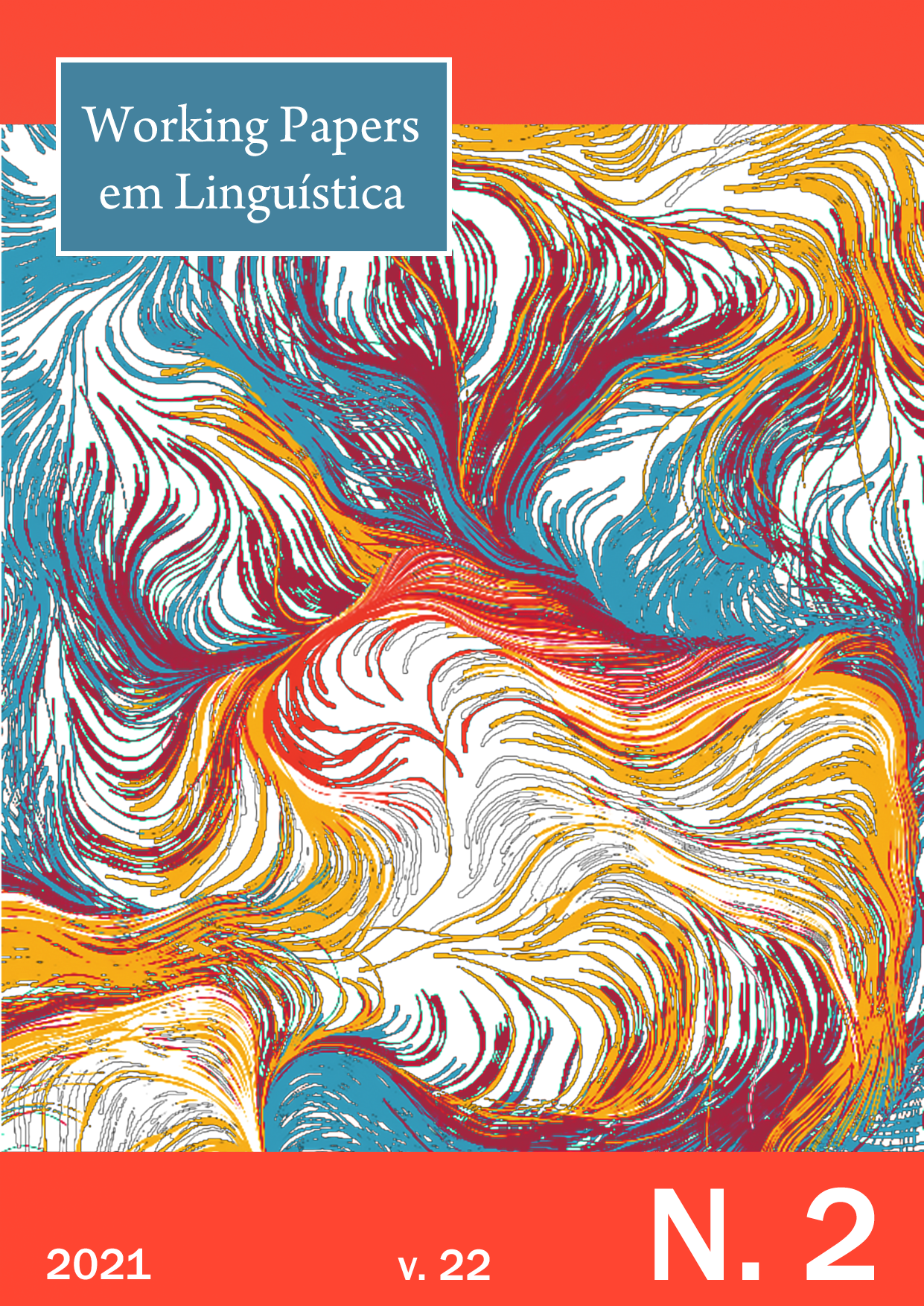A influência espanhola na natureza lexical da marcação diferencial de objeto no português antigo
DOI:
https://doi.org/10.5007/1984-8420.2021.e76075Resumen
Casos em que o objeto direto é morfologicamente marcado por uma preposição são classificados como instâncias da Marcação Diferencial de Objeto (MDO). Além disso, a natureza lexical do objeto é apontada como um fator que desencadeia a MDO. Este artigo tem como objetivo investigar a natureza lexical dos objetos marcados e verificar sua relação com a hipótese da influência da língua espanhola na MDO no português antigo. Essa hipótese é motivada pelo aumento das ocorrências do fenômeno no século XVII. Entre 1580 e 1640, Portugal e Espanha formavam uma unidade política e, consequentemente, as línguas portuguesa e espanhola estavam em contato. Através da análise de textos dos séculos XVI ao XIX, a natureza lexical dos casos da MDO é investigada. Ademais, são comparados dados de objetos marcados e não marcados dos séculos XVI e XVII para verificar a extensão da influência espanhola nos objetos do português. A análise dos dados confirma a hipótese inicial com o aumento dos casos da MDO e mostra, também, que a MDO pode ser desencadeada por pronomes plenos, pronomes de tratamento, títulos de nobreza e certos DPs, como nomes de divindade e nomes próprios.
Citas
AISSEN, Judith. Differential Object Marking: Iconicity vs. Economy. Natural Language & Linguistic Theory, v. 21, n. 3, p. 435-483, ago. 2003.
ARAÚJO ADRIANO, Paulo A. Sobre a regência verbal da preposição 'a' no português brasileiro, Unicamp. Em andamento.
BOSSONG, Georg. Differential Object Marking in Romance and Beyond. In: WANNER, D.; KIIBBEE, D. (org.). New Analyses in Romance Linguistics. John Benjamins Publishing Company, 1991. p. 143-170.
CLUL (Ed.). P.S. Post Scriptum. Arquivo Digital de Escrita Quotidiana em Portugal e Espanha na Época Moderna. 2014. Disponível em: http://ps.clul.ul.pt.
COMPANY, Concepción. Transitivity and Grammaticalization of Object. The diachronic struggle of direct and indirect object in Spanish. In: FIORENTINO, G. (org.). Romance Objects: Transitivity in Romance Languages. Berlim-Nova Iorque: Mouton de Gruyter, 2003. p. 217–260.
CYRINO, Sonia. Reflexões sobre a marcação morfológica do objeto direto por A em português brasileiro. Estudos Linguísticos e Literários, Salvador, n. 58, p.83-103, 2017.
CYRINO, Sonia; ORDOÑEZ, Francisco. Null objects in Brazilian Portuguese and DOM in Spanish: similarities and differences. In: PARODI, T (org.). Proceedings of the VIII Nereus International Workshop “Referential Properties of the Romance DP in the Context of Multilingualism”. Universität Konstanz, Fachbereich Sprachwissenschaft, p. 103-120, 2018.
DÖHLA, Hans-Jörg. Diachronic convergence and divergence in differential object marking between Spanish and Portuguese. In: BRAUNMÜLLER, K.; HÖDER, S.; KÜHL, K (org.). Stability and Divergence in Language Contact: Factors and Mechanisms. Amsterdã: John Benjamins, 2014. p. 265-289.
GALVES, Charlotte; FARIA, Pablo. Corpus Histórico do Português Tycho Brahe. 2010. Disponível em: http://www.tycho.iel.unicamp.br/~tycho/corpus/en/index.html.
GALVES, Charlotte; NAMIUTI, Cristiane; PAIXÃO DE SOUSA, Maria Clara. Novas perspectivas para antigas questões: revisitando a periodização da língua portuguesa. In: ENDRUSCHAT, A.; KEMMLER, R.; SCHÄFER-PRIESS, B. (org.). Grammatische Structuren des Europäischen Portugiesisch. Turbigen: Calapinus Verlag, 2006. p. 45-75.
GIBRAIL, Alba. O acusativo preposicionado do português clássico: uma abordagem diacrônica e teórica, 2003. 210 p. Dissertação (mestrado) - Universidade Estadual de Campinas, Instituto de Estudos da Linguagem, Campinas, SP, 2003.
HILLS, Elijah Clarence. The Accusative “A”. Hispania, v. 3, n. 4, p. 216-222, 1920.
IRIMIA, Monica; PINEDA, Anna. Differential object marking and Scales: Insights from diachrony. In: Proceedings of the Linguistic Society of America, v. 4, n. 1, p. 1-15, 2019.
MEIER, Harri. Sobre as origens do acusativo preposicional nas línguas românicas. In: Ensaios de filologia românica. Lisboa: Revista de Portugal, 1948. p. 155-164.
RAMOS, Jânia. Marcação de caso e mudança sintática no português do Brasil: uma abordagem gerativa e variacionista, 1992. [380]f. Tese (doutorado) - Universidade Estadual de Campinas, Instituto de Estudos da Linguagem, Campinas, SP, 1992.
REINA, Javier Caro. Differential object marking with proper names in Romance languages. In: KEMPF, L.; NÜBLING, D.; SCHMUCK, M. (org.). Linguistik der Eigennamen: Linguistik, Impulse & Tendenzen. Berlim-Boston: De Gruyter, 2018. p. 225-259.
TORREGO, Esther. El complemento directo preposicional. In: BOSQUE, I.; DEMONTE, V. (org.). Gramática descriptiva de la lengua española. Madrid: Espasa, 1999. p.1779-1805.
VÁSQUEZ CUESTA, Pilar. A língua e a cultura portuguesas no tempo dos Filipes. Mira-Sintra: Publicações Europa-América, 1986. 152p. (Colecção saber, 204). ISBN 972102676X.
Descargas
Publicado
Número
Sección
Licencia
Os direitos autorais de trabalhos publicados são dos autores, que cedem à Revista Working Papers em Linguística o direito de publicação, ficando sua reimpressão, total ou parcial, sujeita à autorização expressa da Comissão Editorial da revista. Deve ser consignada a fonte de publicação original. Os nomes e endereços de e-mail neste site serão usados exclusivamente para os propósitos da revista, não estando disponíveis para outros fins.
The names and email addresses entered in this journal site will be used exclusively for the stated purposes of this journal and will not be made available for any other purpose or to any other party.
Esta obra está licenciada sob licença Creative Commons - Atribuição-NãoComercial- 4.0 Internacional.


